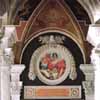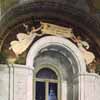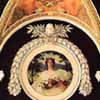
TABLE
OF CONTENTS - Introduction - A
Brief History of the Library of Congress
The Thomas Jefferson Building - The
John Adams Building - The James Madison Memorial
Building
Author's Note and Acknowledgements - Further
Reading - Concordance of Images
INTRODUCTION
The three imposing buildings of the Library of Congress--the Thomas Jefferson Building, the John Adams Building, and the James Madison Memorial Building--are remarkable but very different public spaces and public works of art. Located just east of the U.S. Capitol Building, each in its own way is a powerful and impressive symbol of learning and democracy and of American culture and self-confidence. The inscriptions and quotations on the walls and ceilings of each building express the Library's ambitious mission of collecting and sharing the wisdom of all civilizations.
 A quotation from Proverbs 4:7 in the Bible is paired with
Robert Reid's painting Understanding in the Jefferson's
Building's Great Hall (Photograph by Carol M. Highsmith)
A quotation from Proverbs 4:7 in the Bible is paired with
Robert Reid's painting Understanding in the Jefferson's
Building's Great Hall (Photograph by Carol M. Highsmith)
The Jefferson Building (1886-1897) is a reflection of a time that considered it possible to contain all knowledge within the walls of a single building. Designed and built in leaner times and primarily for functional purposes, the Adams (1930-1939) and Madison (1965-1980) Buildings nevertheless employ the words and symbols of history--and especially the words of the founding fathers.
The architecture of the Library's buildings generally overpowers the inscriptions and quotations described in the pages that follow. Thus this book's purpose is to help visitors, especially in the Jefferson Building with its ebullient and often breathtaking interior, to locate, identify, and appreciate these names and phrases and their authors and creators.
 The
U.S. Capitol, the home of the Library of Congress until 1897, is
seen at sunrise through a window in the Jefferson Building's North
Mosaic Corridor. A quotation from Confucius is being unfurled
near the ceiling. (Photograp h by Carol M. Highsmith)
The
U.S. Capitol, the home of the Library of Congress until 1897, is
seen at sunrise through a window in the Jefferson Building's North
Mosaic Corridor. A quotation from Confucius is being unfurled
near the ceiling. (Photograp h by Carol M. Highsmith)
Although the emphasis in the book is on words, not works of art, I cannot resist pointing out a few of the most memorable decorative features described in the pages that follow.
Outside of the Jefferson Building, the visitor should make a special point of spending a few minutes at the Neptune Fountain. In the Great Hall, the cherubs on the staircases and their various occupations are worth special attention, as are the classically-composed football and baseball players in the second floor Great Hall ceiling; the symbolic and dominant figure of Minerva, viewed as one ascends to view the Main Reading Room; and the remarkable "Evolution of Civilization" mural in the collar of the Main Reading Room's dome. The owl, a symbol of wisdom, is seen throughout the decoration in the Jefferson Building and Adams Buildings; my favorites are the streamlined owls that stand guard on the stairs outside of the unused south entrance to the Adams Building. A formidable and inspiring four-story high relief of cascading bronze books rises above the entrance to the Madison Building.
The Thomas Jefferson Building opened on November 1, 1897. Soon thereafter, one admiring member of the public, Joseph E. Robinson, exclaimed to the Librarian of Congress: "not until I stand before the judgement seat of God do I ever expect to see this building transcended." My hope is that this guidebook will help others share at least a measure of Mr. Robinson's enthusiasm--for all of the Library's buildings.
 Summer,
by Frank W. Benson, is one of the four seasons portrayed in the
ceiling of the South Corridor on the second floor of the Jefferson
Buidling's Great Hall. The printers' mark of the 16th century printer
Simon Vostre can be seen directly above the painting. (Photograph
by Carol M. Highsmith)
Summer,
by Frank W. Benson, is one of the four seasons portrayed in the
ceiling of the South Corridor on the second floor of the Jefferson
Buidling's Great Hall. The printers' mark of the 16th century printer
Simon Vostre can be seen directly above the painting. (Photograph
by Carol M. Highsmith)
TABLE
OF CONTENTS - Introduction - A
Brief History of the Library of Congress
The Thomas Jefferson Building - The
John Adams Building - The James Madison Memorial
Building
Author's Note and Acknowledgements - Further
Reading - Concordance of Images
Contact Us ( January 11, 2006 )